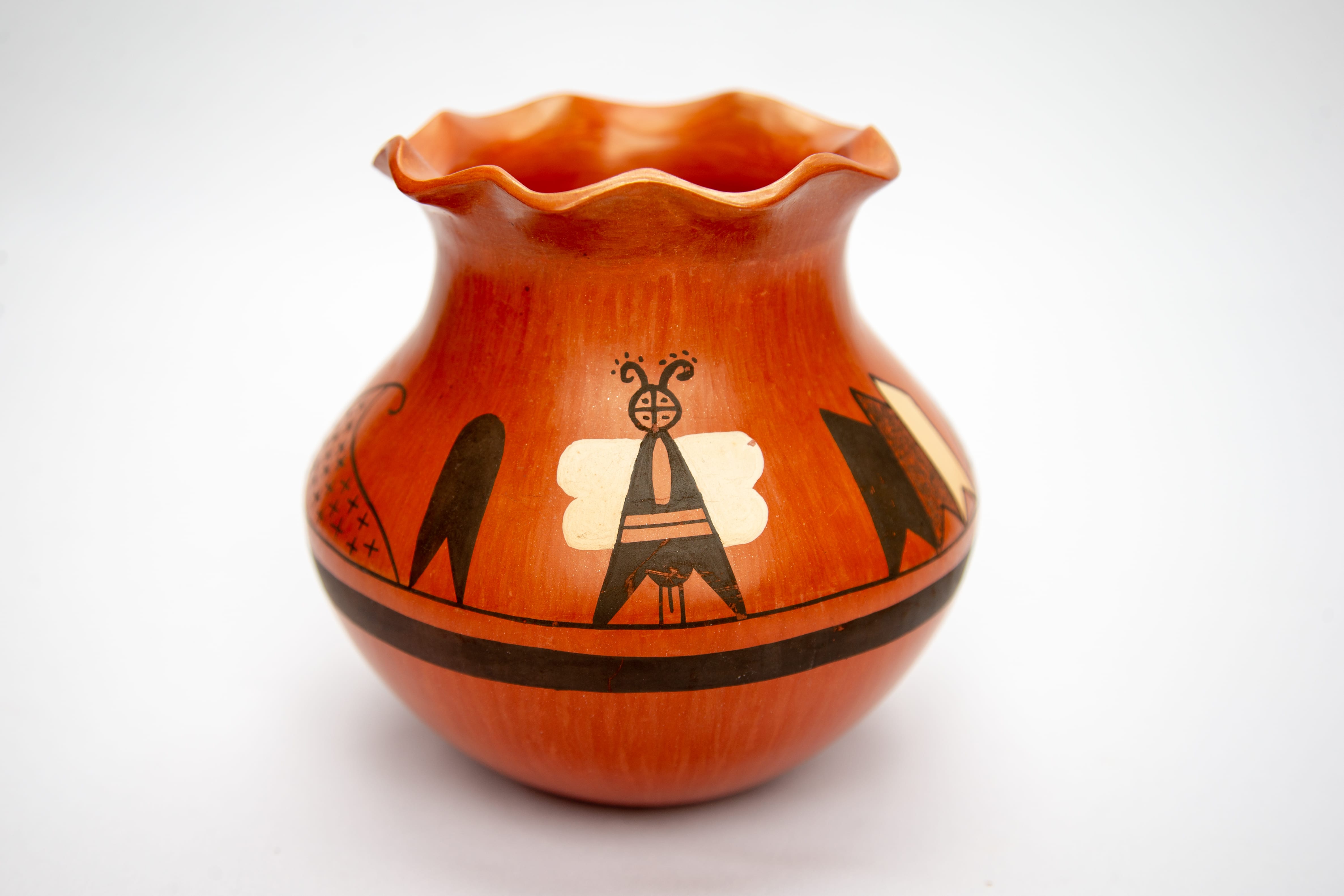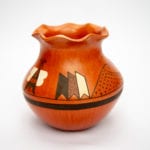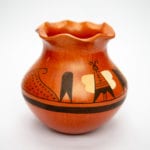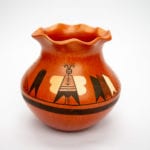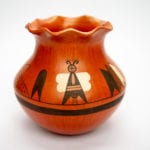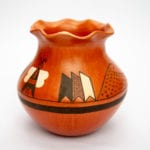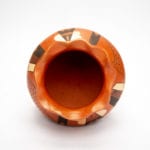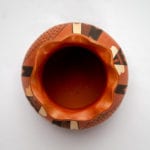This jar may be formed from “sikyatska,” yellow clay that fires red in a low-temperature dung-fueled fire. However, thumping the jar with a finger produces a high-pitched ring, the sign of high-temperature kiln firing. I don’t know enough about Hopi clay to know which clay fires brick red in a kiln. Once the pot was coiled, scraped and sanded, Larson polished the surface with a smooth stone. Generally such polishing is done with random strokes until the surface shines. Here Larson has chosen a more difficult technique of polishing the jar in line with its vertical axis, thus creating a subtle pattern of faint parallel lines on the surface that reflect the light. This “onion skin” effect gives the jar an extra vitality.
Just below the waist of the jar Larson has painted a wide black line around the circumferance. Just above it a simiular thin line encircles the pot.. This thin line forms the base for a procession of four designs, the sequence repeated twice.The painting is monochromatic except for two white elements.. First is a large wave filled with a swarm of small X’s, followed by black strip like an arrow with a rounded head and a notched bottom, followed by a butterfly. The butterfly is drawn around a triangular body with a black lower section with three protruding parallel lines. Drawn in the center of the body is a descending arrow crossed by two short lines. Just below the head of the arrow are two parallel lines that form a belt. Bi-lobed white wings emerge from the length of the body. On both renditions of the butterfly the head is surmounted by curved antennae supporting 7 or 8 dots. The faces of the two butterflies are different, however, inticating two genders (Struever, 2008:93). One face is square and encloses a cross. The second is round and also has a cross, but here there is a dot in each of the four quadrants. Following the butterfly is the final design element, a set of three more arrows, but this time with pointed heads and each a different color: black, stippled and white.
The design on 2010-22 is adapted directly from a Sikyatki pot excavated by Jesse Fewkes in 1895 and published in the 17th Annual Report of the Bureau of American Ethnology (Fewkes 1898:plate CXXXV following p. 678 and fig 271, p. 679) and the 33rd Report in 1919. In this later Report he reprints a 9-inch wide black and sepia fold-out of the top of the vase (1919:following p. 277). Both reports were reprinted as a single volume in 1973. In 1898 Fewkes called this design:
“the most beautiful of all the butterfly designs…The elaborate decoration of the zone outside the six butterflies is made up of feathers arranged in three clusters of three each, alternating with key patterns, crosshatched crooks, triangles, and frets. The wealth of ornament on this part of the vase is noteworthy, and the interpretation very baffling. This vase may well be considered the most elaborately decorated in the whole collection from Sikyatki (1898:678-680; 1973:54-56).
This prehistoric Sikyatki polychrome is now in theDepartment of Anthropology, Smithsonian Museum (item #155681). For a different Sikyatki jar with a similar design, see Jacka, 1988:7. In modern times the design was revived and made famous by Grace Chapella (2010-22 and 2011-19) who taught it her descendants Mark Tahbo (1995-01 and 1997-08) and his sister Dianna Tahbo (1992-06).
The interpretation of the design might have been ” very baffling” to Fewkes in 1895, but since prehistoric times represents a central “braided streams of meanings” to Native people in the Southwest and Mesoamerica (Hays-Gilpin, Newsome and Sekaquaptewa, 2010: 121-177 and Sekaquaptewa and Washburn, 2006:k26-47):
“Hopi songs describe Siitalpuva, ‘along (or throughout) the flowery land,’ ‘along fields in bloom,’ ‘the land brightened with flowers,’ as a place that ‘shines forth’ with colored blossoms, birds and butterflies. This flowery world is not a seperate place, like the Christian Heaven, but a reality that can be brought forth in this world through human prayers, songs and actions (Hays-Gilpin, Newsome and Sekaquaptewa, 2010: 122).”
I purchased this vase in November 2017. During at least the year that followed, no appreciable rain fell at Hopi. Crops that were planted failed. Many farmers saved their seed corn and did not plant. In the old days drought would foretell starvation times. In the present day, life becomes very difficult. If normal rain (about 8 inches a year) come again, the dusty desert will turn green and flowers will bloom. Hummingbirds will drink necter; butterflies will flutter by and the Hopi people will have great gratitude for the renewed desert life. I have seen Siitalpuva at Hopi and its blessing of such a landscape is clear.
I had a chance to discuss this design with Mark Tahbo at the Hopi Market at the Museum of Northern Arizona in July 2007. When Mark was in his mid-20’s and establishing himself as a potter, he followed the lead of his great grandmother Grace Chapella and made many versions of this design. Mark interpreted the three pointed elements as representing the Hopi mesas. He said the crosshatched wave image represents cornfields surrounded by water, the butterflies the burst of life after spring rains. The vertical lines with cross hatchings represent prayer feathers (pathos) suspended from a string (nakwakwoci), the typical prayer offerings for rain at Hopi. His understanding may be different than that of the woman who 600 years ago made the butterfly pot excavated by Fewkes, but there has always been conversation between the landscape of Hopi and the design of Hopi pots (and kiva walls) and I believe Mark’s explanation to be an expression of tradition.
Larson is a very-talented potter and painter. The painting of Siitalpuva on jar 2017-14, however, is somewhat static and stilted. I am guessing that he painted this pot early in his career, perhaps when Mark Tahbo was one of his teachers.

